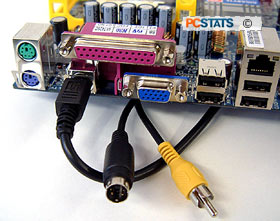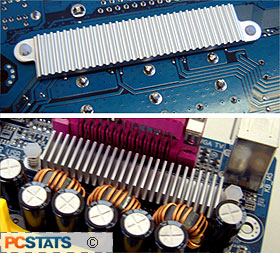The ATI Radeon 9100 IGP Pro
as it is called, is essentially a tweaked version
of the RS300, and so the big question on all our minds is whether or not
this will enable ATI to really compete with established chipset manufacturers... on any level. Whatever
the result ends up, the more chipset options on the market, the better for all consumers.
The Gigabyte GA-8TRS350MT
mainboard PCstats is testing for you today is obviously based on the 'RS350' ATI Radeon
9100 IGP PRO Northbridge and ATI IXP 300 Southbridge. The GA-8TRS350MT includes such standard system integrator
favourites as DX8.1 integrated video, 10/100 LAN, 5.1-channel audio codec, and
TV-out.

Alongside the three PCI slots is an 8X AGP socket, space for four DDR
RAM sticks, two SATA RAID 0,1 devices and two ATA100 IDE
channels. Make no mistake though, this compact socket 478
Intel Pentium 4 (including Prescott) motherboard is focusing its feature set towards the needs and demands of
the value-oriented systems, with a some multimedia connectivity thrown in for good
measure...
It's true that there are already chipsets on the market with integrated video
from both SIS and Intel, but neither solution can match ATi's performance or
multimedia
powers. The main reason is that the Radeon 9100IGP Pro is built with
Radeon 9200 GPU-class graphics, and comes with TV-out on top of everything! The GA-8TRS350MT also comes
with a SVideo/composite cable that is about a meter in length, which is always handy.
 These days computers can fall prey to many
different ailments. Worms are the most common, so it is nice to
see Gigabyte bundle in some software from Norton (Internet Security 2004) to address this issue.
These days computers can fall prey to many
different ailments. Worms are the most common, so it is nice to
see Gigabyte bundle in some software from Norton (Internet Security 2004) to address this issue.
While this
layout and physical features of the GA-8TRS350MT motherboard are pretty standard, there is one
addition that caught our attention. The motherboard power supply mosfet's are cooled with
a small aluminum heatsink that is positioned to take advantage of the air leaving the processor.
There is nothing remarkable about this,
many manufacturers use heatsinks, heatpipes, fans, or fan ducts to achieve the
same end result. What stands out is on the other side of the motherboard...
Flipping the board
over, we find another low profile aluminum heatsink on the opposite side of the mainboard. Since
much of the heat these electrical components produce is 'sinked to the PCB through the solder
joint, I suppose the design engineers are trying to capitalize on that
for some extra cooling. Still, this is a rather interesting application of the heatsink.

